Title: Night club owner, beer bootlegger, gangster
Birthdate: September 8, 1888
Death Date: August 29, 1931
Plot Location: Section C, Lot 5
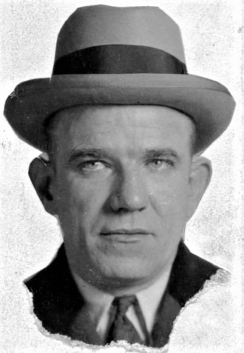
“Mickey Duffy” was born in the Gray’s Ferry area of Philadelphia to Polish immigrant parents John and Elizabeth Cusick. His given name was either Michael Joseph or William Michael, although Michael J. is used on his census reports and gravestone. In an attempt to gain acceptance with the Irish gangs of his home town, he used a variety of names, finally settling on Michael “Mickey” 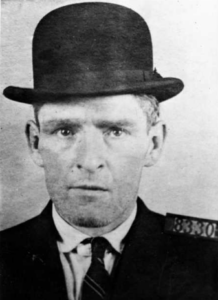 Duffy.
Duffy.
His life of crime began with petty thefts and various misdemeanors as an adolescent, quickly rising through the ranks to become one of Philadelphia’s most notorious gangsters. His first arrest came in 1908. Throughout his lifetime he would serve jail time for a variety of offences including an almost three-year stint at the famed Eastern State Penitentiary for assault and battery with intent to kill.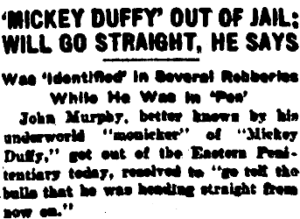
The era of prohibition was in full swing when he was released. Mickey married a former hat-check girl named Edith and easily found his way in the world of bootlegging and brewing. He operated several breweries in Philadelphia and Camden, and became known as the beer baron of South Jersey. These lucrative operations allowed him to invest in more traditional, legitimate businesses including the fashionable Club Cadix on Chestnut Street.
He and Edith were leaving the club on February 25, 1927; Edith had just sat down in the car when Mickey, his 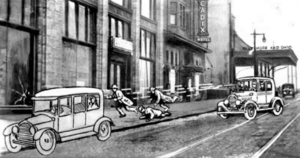 bodyguard, John Bricker, and the club doorman were met with a hail of gunfire in a drive-by shooting. It was reported to be the first gangster “Tommy” gun shooting. Bricker was killed, the club doorman was seriously injured and Duffy was hit multiple times.
bodyguard, John Bricker, and the club doorman were met with a hail of gunfire in a drive-by shooting. It was reported to be the first gangster “Tommy” gun shooting. Bricker was killed, the club doorman was seriously injured and Duffy was hit multiple times.
He was taken to Hahneman Hospital where he was given last rites. Newspapers said at first that Mickey was not expected to live, but he was back to his gangster work within weeks of the shooting. When he left he gave the hospital $1000 in appreciation for saving his life. He also erected a unique monument to his beloved bodyguard, who was buried here in Section D. (Read John Bricker’s Notable life story here.)
He maintained luxurious suites in Philadelphia’s Ritz Carlton, The Walt Whitman Hotel in Camden, and the Ambassador Hotel in Atlantic City, but home for Mickey and his wife was a Lower 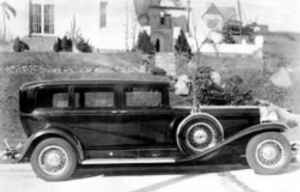 Merion mansion on City Avenue. The home was built in 1929 as an architectural showcase by the firm of McWilliams and Maloney at an approximate cost of $90,000. It was purchased by the Duffys in 1930. Mickey’s Duesenberg, his pride and joy, is shown here in front of the mansion.
Merion mansion on City Avenue. The home was built in 1929 as an architectural showcase by the firm of McWilliams and Maloney at an approximate cost of $90,000. It was purchased by the Duffys in 1930. Mickey’s Duesenberg, his pride and joy, is shown here in front of the mansion.
Mickey added some personal touches to the home: wiring the doors and windows to a central alarm system, reinforcing some doors and walls with steel plates, installing floodlights in the shrubbery and building a secret room with steel walls. The Mediterranean-style home was known as “the House of the Black Palm” or “the Black Palm Castle” due to its trademark black metal palm tree which spread across the stucco façade of the mansion. The home changed hands several times in the decades after Duffy’s death and no longer stands. It was bulldozed in 1970, taking with it the colorful memories of its notorious original owner.
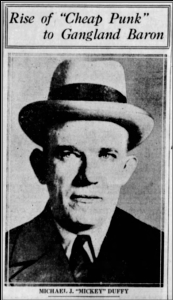 Throughout his life, Mickey Duffy was known as a hoodlum, racketeer, beer baron, ex-con, gangster, bootlegger, hijacker, thief, and smuggler. In 1930 he was dubbed “King of the Numbers Racket” by Philadelphia District Attorney John Monaghan and for a brief time was known as Public Enemy #1 in Philly. His lavish lifestyle included his magnificent home, fancy cars, fashionable clothes and flashy jewels for his wife.
Throughout his life, Mickey Duffy was known as a hoodlum, racketeer, beer baron, ex-con, gangster, bootlegger, hijacker, thief, and smuggler. In 1930 he was dubbed “King of the Numbers Racket” by Philadelphia District Attorney John Monaghan and for a brief time was known as Public Enemy #1 in Philly. His lavish lifestyle included his magnificent home, fancy cars, fashionable clothes and flashy jewels for his wife.
He lived the life of a crime “big shot” but invariably made some enemies along the way. On August 29, 1931 while sleeping in his suite at the Ambassador Hotel in Atlantic City, Mickey was murdered. There was speculation that he was killed by his own associates in an attempt to seize his power and business. Although police investigated the murder and had an array of suspects, no one was ever charged with the murder.
The funeral drew huge crowds lining 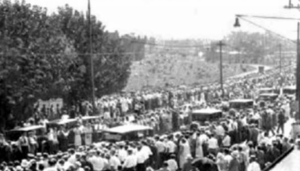 Kingsessing Street by the cemetery to see his funeral procession. Police turned away spectators and only family and friends with a special pass were allowed to enter. Part of the 31-car procession is shown here entering Mt. Moriah, where he was reportedly buried in a solid bronze coffin. Souvenir hunters took flowers from the hundreds of floral tributes left at the grave site.
Kingsessing Street by the cemetery to see his funeral procession. Police turned away spectators and only family and friends with a special pass were allowed to enter. Part of the 31-car procession is shown here entering Mt. Moriah, where he was reportedly buried in a solid bronze coffin. Souvenir hunters took flowers from the hundreds of floral tributes left at the grave site.
His simple gravestone has his name on the right side 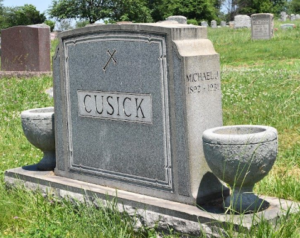 and his mother’s name (who died of tuberculosis in 1906) on the left.
and his mother’s name (who died of tuberculosis in 1906) on the left.
Ironically, Duffy’s personal estate was valued at only $6,000. Administration papers showed $5,000 worth of personal property and $1000 equity in a home on Osage Avenue in Philadelphia. (The City Avenue mansion was owned jointly with Edith.) In 1932 several tax liens were levied against the estate and in 1933 the funeral director who buried Mickey sued the estate to recover the funeral costs. Unfortunately by that time, Mickey’s widow Edith could not be located.
The HBO series “Boardwalk Empire” has a character named Mickey Doyle who is based on the real life Mickey Duffy.

Support the Friends of Mount Moriah
Help us in our mission to restore and maintain the beautiful Mount Moriah Cemetery by donating to our cause or volunteering at one of our clean-up events.

